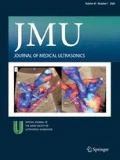Abstract
We describe the case of a neonate who was prenatally diagnosed at a gestational age of 36 weeks with premature constriction of the ductus arteriosus. Blood from the thin ductus arteriosus flowed toward the pulmonary artery. Severe tricuspid regurgitation was also observed. We subsequently confirmed rupture of the tricuspid papillary muscle after birth. Cardiotonic drugs and nitric oxide were administered immediately at birth for pulmonary hypertension, and this therapy was continued until the seventh postnatal day. Emergency tricuspid valve repair was unnecessary, because there were no signs of severe circulatory insufficiency. This case suggests a relationship between prenatally diagnosed premature constriction of the ductus arteriosus and tricuspid papillary muscle rupture in neonates.




Similar content being viewed by others
References
Huhta JC, Moise KJ, Fisher DJ, et al. Detection and quantitation of constriction of the fetal ductus arteriosus by Doppler echocardiography. Circulation. 1987;75:406–12.
Luchese S, Mânica JL, Zielinsky P. Intrauterine ductus arteriosus constriction: analysis of a historic cohort of 20 cases. Arq Bras Cardiol. 2003;81:405–10.
Auer M, Brezinka C, Eller P, et al. Prenatal diagnosis of intrauterine premature closure of the ductus arteriosus following maternal diclofenac application. Ultrasound Obstet Gynecol. 2004;23:513–6.
Ishida H, Kawazu Y, Kayatani F, et al. Prognostic factors of premature closure of the ductus arteriosus in utero: a systematic literature review. Cardiol Young. 2016;20:1–5.
Yoon JK, Kim HR, Kwon HW, et al. Ruptured tricuspid valve papillary muscle in a neonate with intractable persistent fetal circulation. Korean Circ J. 2015;45:340–3.
Benvenuti LA, Aiello VD, Cury AJ, et al. Post-ischemic rupture of the anterior papillary muscle of the right ventricle associated with persistent pulmonary hypertension of the newborn: a case report. Am J Cardiovasc Pathol. 1992;4:79–84.
Kaulitz R, Haen S, Sieverding L, et al. Intrauterine rupture of anterior tricuspid valve papillary muscle: tricuspid valve chordae replacement on the first day of life. J Thorac Cardiovasc Surg. 2012;143:241–3.
Sachdeva R, Fiser RT, Morrow WR, et al. Ruptured tricuspid valve papillary muscle: a treatable cause of neonatal cyanosis. Ann Thorac Surg. 2007;83:680–2.
Author information
Authors and Affiliations
Corresponding author
Ethics declarations
Conflict of interest
None.
Ethical statement
Informed consent was obtained from the patient’s parent to publish his case.
About this article
Cite this article
Inatomi, A., Sasahara, J., Ishii, K. et al. Prenatal diagnosis of premature constriction of the ductus arteriosus with tricuspid papillary muscle rupture: a case report. J Med Ultrasonics 45, 337–340 (2018). https://doi.org/10.1007/s10396-017-0807-4
Received:
Accepted:
Published:
Issue Date:
DOI: https://doi.org/10.1007/s10396-017-0807-4




